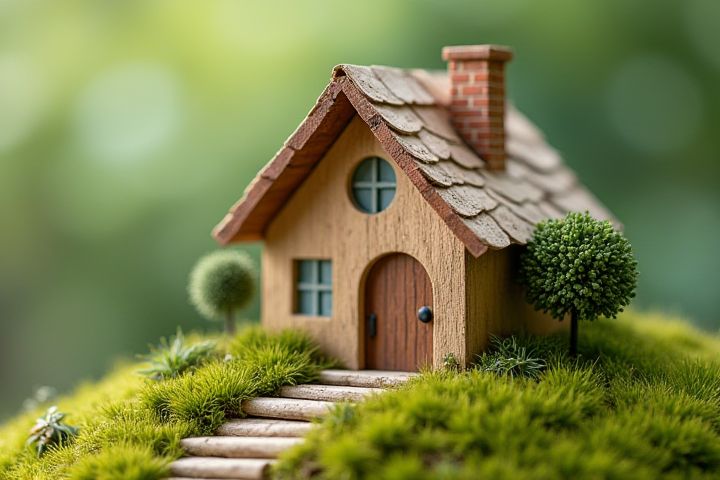
To create an eco-friendly house, focus on energy-efficient appliances that reduce electricity consumption and lower utility bills. Implement renewable energy sources, such as solar panels, to harness clean energy and potentially generate excess power for resale. Use sustainable building materials like bamboo, reclaimed wood, or recycled steel, which have a lower environmental impact and enhance durability. Insulating your home with eco-friendly materials, like cellulose or sheep's wool, can significantly improve thermal efficiency and comfort year-round. Finally, incorporating a rainwater harvesting system allows you to recycle water for irrigation, further minimizing your environmental footprint and promoting water conservation.
How To Make A House Eco-Friendly
Install solar panels
Installing solar panels can significantly reduce your household's carbon footprint, harnessing sunlight to generate clean energy. By converting solar radiation into electricity through photovoltaic cells, solar panels can save you up to 50-70% on your energy bills, depending on your location and energy consumption. In many regions, government incentives or tax credits can offset the initial installation costs, making this upgrade more affordable. Over a typical lifespan of 25-30 years, homeowners can reap substantial savings while contributing to a sustainable environment.
Use energy-efficient appliances
Using energy-efficient appliances is a crucial step toward creating an eco-friendly home. Energy Star-rated devices, such as refrigerators, washers, and ovens, consume significantly less energy than standard models, often reducing energy usage by around 10-50%. By replacing older appliances, you can lower utility bills and decrease your carbon footprint, contributing to a healthier planet. Additionally, consider smart home technologies that optimize energy use, allowing you to monitor and reduce consumption easily.
Implement proper insulation
Proper insulation is crucial for making your home eco-friendly by significantly reducing energy consumption. Insulation materials such as cellulose, fiberglass, or spray foam can provide an R-value, the measure of thermal resistance, between 13 and 38, depending on the type and location. By effectively sealing gaps and ensuring high-quality insulation in walls, attics, and floors, you can decrease heating costs by up to 40%. This not only lowers your carbon footprint but also enhances indoor comfort throughout all seasons.
Harvest rainwater
Harvesting rainwater is an effective method to make your home more eco-friendly. By installing a rainwater collection system, you can capture runoff from your roof and store it in barrels or a cistern, reducing your reliance on municipal water. This collected water can be utilized for irrigation, landscaping, and even non-potable household purposes, conserving precious resources. Incorporating filtration and purification systems ensures that the water is clean and safe for a variety of uses, promoting sustainability in your daily water consumption.
Use sustainable materials
Using sustainable materials is crucial for making your house eco-friendly. Opt for recycled materials, such as reclaimed wood for flooring and furniture, which reduces waste and minimizes deforestation. Incorporate environmentally friendly insulation options, like cellulose or sheep's wool, to enhance energy efficiency while maintaining indoor air quality. Selecting low VOC (volatile organic compounds) paints and finishes not only helps improve the air you breathe but also contributes to a healthier living environment.
Plant a green roof or vertical garden
Planting a green roof or vertical garden significantly enhances your home's eco-friendliness by improving insulation and reducing energy consumption. These living structures not only provide a natural habitat for wildlife but also absorb rainwater, decreasing stormwater runoff and helping to manage urban heat. Utilizing native plants for your vertical garden can lower maintenance requirements and promote local biodiversity. By choosing to implement a green roof, you contribute to cleaner air quality and a more sustainable urban environment, making your home a greener haven.
Install energy-efficient windows
Installing energy-efficient windows can significantly reduce your home's energy consumption, with potential savings of 15% to 30% on heating and cooling costs. These windows typically feature double or triple glazing, which helps insulate your home against temperature fluctuations. Look for products with low-E (low emissivity) glass, as they reflect heat back into your home during winter and keep unwanted heat out in summer. When replacing or upgrading your windows, ensure proper sealing and installation to maximize efficiency and minimize drafts.
Use LED lighting
Using LED lighting is a crucial step in making your house eco-friendly. LEDs consume up to 75% less energy than traditional incandescent bulbs, significantly reducing your electricity bill and carbon footprint. They also have a longer lifespan, lasting up to 25,000 hours, which means less frequent replacements and less waste in landfills. By incorporating LED fixtures throughout your home, you enhance energy efficiency while promoting a sustainable living environment.
Implement smart home systems
Implementing smart home systems can significantly enhance your home's eco-friendliness while optimizing energy usage. Smart thermostats can reduce heating and cooling costs by up to 30%, adjusting temperatures based on occupancy and preferences. Smart lighting systems, utilizing LED technology, can cut electricity use by around 75%, with automated controls that minimize wastage. Lastly, integrating smart appliances can help monitor energy consumption, allowing you to make informed decisions that lead to cost savings and reduced environmental impact.
Incorporate passive solar design
Incorporating passive solar design into your home is a highly effective way to enhance energy efficiency and comfort. Focus on optimizing your layout to take advantage of natural sunlight, positioning larger windows on the south side to maximize solar gain during winter months while minimizing heat in the summer through overhangs or awnings. Insulating walls and using thermal mass materials, such as concrete or stone, can help retain heat during colder periods and coolness when it's warmer. By strategically designing your home to utilize sunlight, you not only reduce reliance on conventional heating and cooling systems but also contribute to a more sustainable living environment.
